Yesterday morning a change in shooting strategy allowed me to get some kingfisher photos that have eluded me for years.
Until yesterday I’d never been able to get frame-filling (after only moderate cropping), sharp photos of a hovering kingfisher. I have photos of them hovering at a distance but not up close with good detail.
There’s a reason for that. When kingfishers hover (they don’t always) they typically do it after they take off after a fish but before they hit the water. If I get the takeoff shot, which in the past I’ve always tried to do, I usually don’t have time to get them back in frame and in focus while they’re hovering before they dive on the fish. Their hover usually doesn’t last long enough for that.
So yesterday I decided to sacrifice the takeoff shot by not even trying for it. Instead, I’d wait and watch until the male kingfisher began to hover and then try to get him in my viewfinder and in focus before he dropped on the fish.
The first time I tried it, it worked. I got 16 sharp photos of him hovering without clipping any body parts. But as luck would have it, in the first seven shots he was facing directly toward me, while looking down, so there was absolutely no light in either eye.
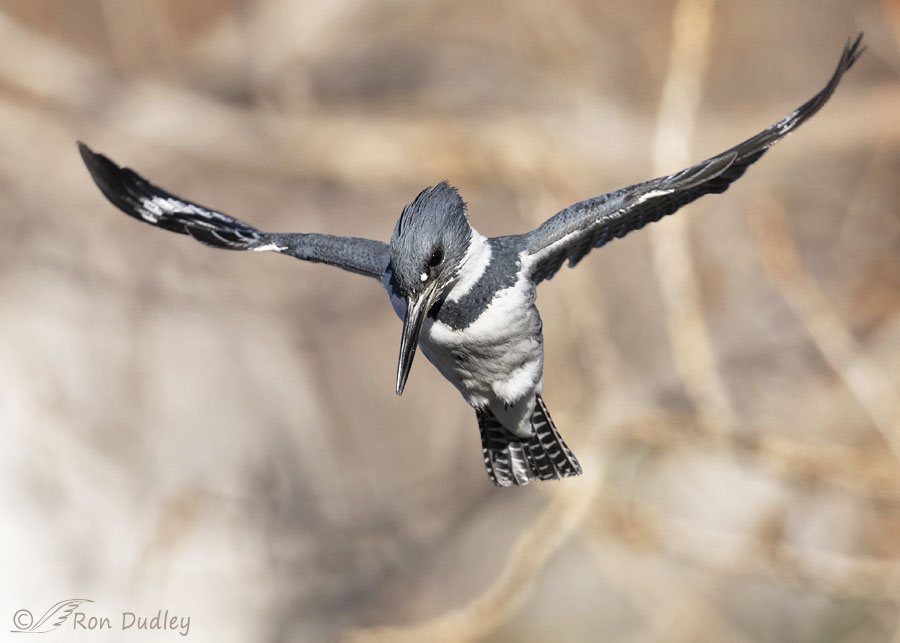
1/3200, f/6.3, ISO 640, Canon R5, Canon EF500mm f/4L IS II USM + 1.4 tc, not baited, set up or called in
But just before he dove on the fish while hovering his angle changed slightly, just enough to provide a tiny catch light in his left eye. This photo and the following three are consecutive shots in the burst without any skips.
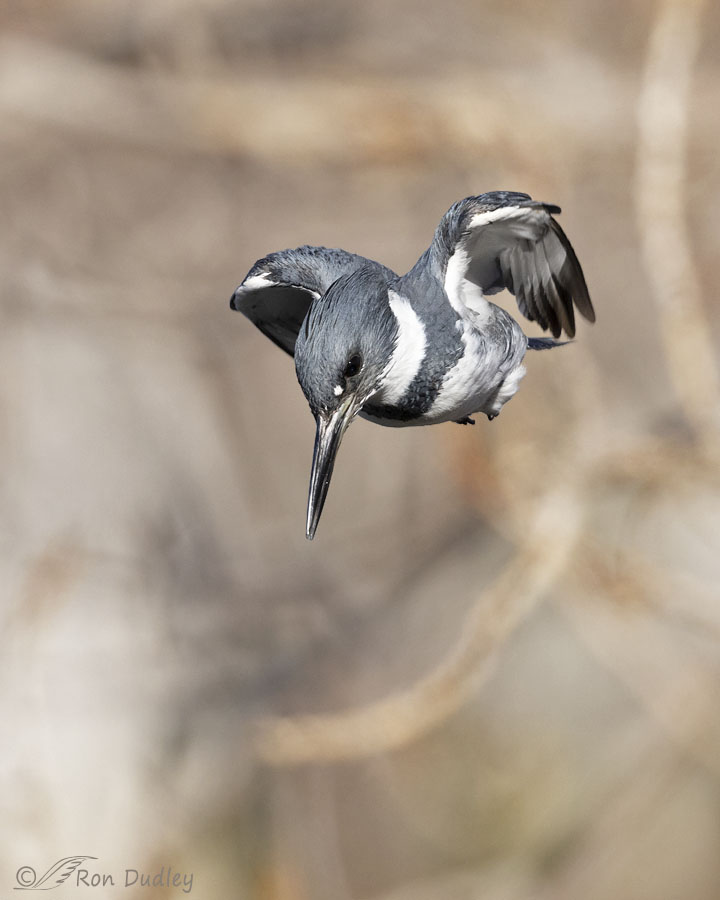
1/3200, f/6.3, ISO 640, Canon R5, Canon EF500mm f/4L IS II USM + 1.4 tc, not baited, set up or called in
Here his body is beginning to rotate from hovering and into the dive.
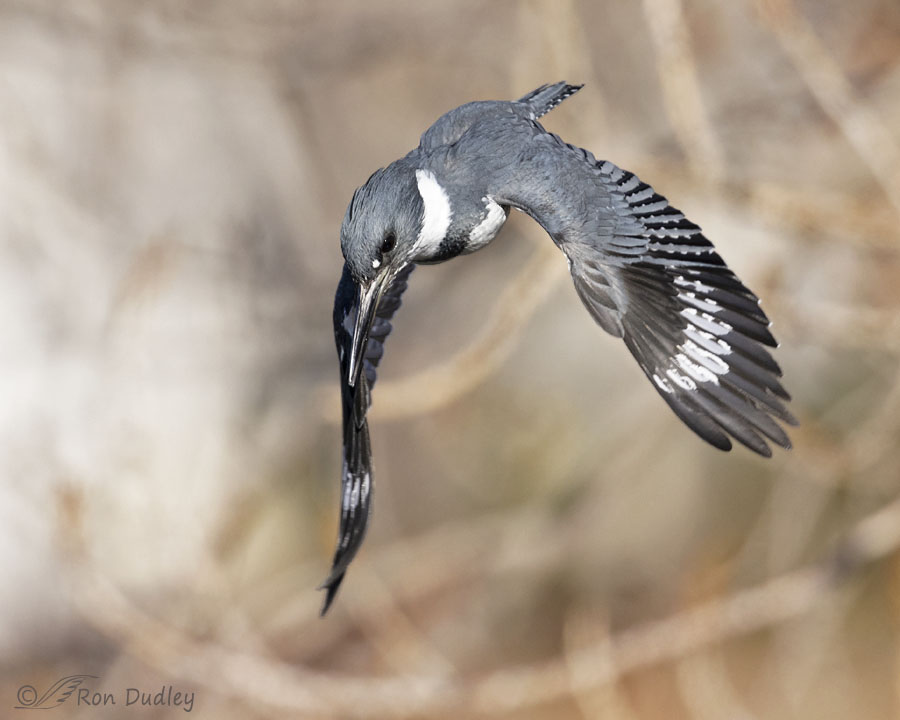
1/3200, f/6.3, ISO 640, Canon R5, Canon EF500mm f/4L IS II USM + 1.4 tc, not baited, set up or called in
Still rotating. Because of insufficient depth of field his right wing is soft.
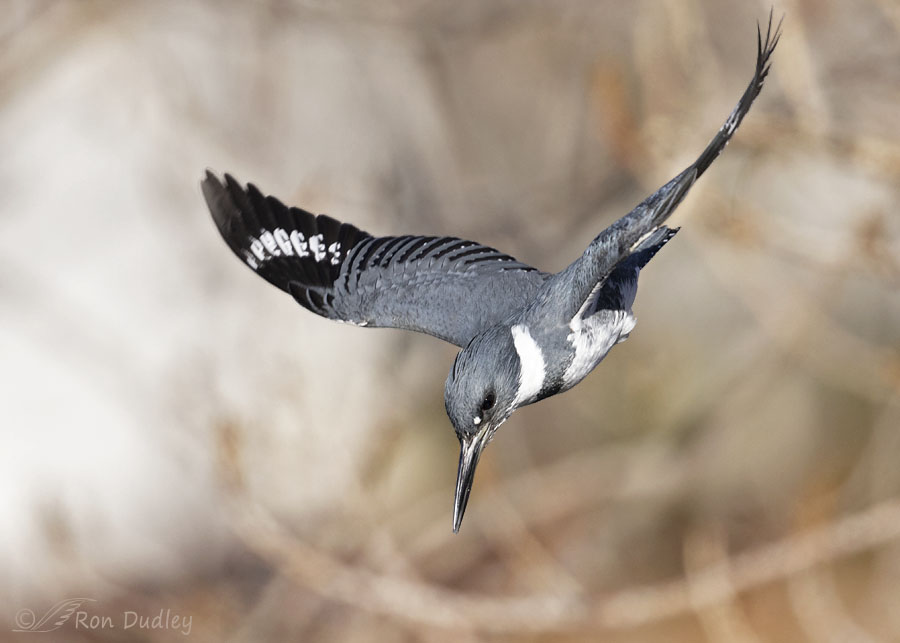
1/3200, f/6.3, ISO 640, Canon R5, Canon EF500mm f/4L IS II USM + 1.4 tc, not baited, set up or called in
In this last shot his dive has begun. It’s the last shot I got without cutting off body parts at the bottom of the frame. In case you’re wondering, he missed the fish.
If felt pretty good to have some success the first time I tried a new strategy. I’m such a creature of habit I tend to be an old stick in the mud and do things the same way again and again, forever.
Yesterday was another reminder to try to be a little more flexible. I’ll work on it.
Ron
Notes:
Yesterday’s blog post was about the problem I had two days ago, getting soft photos in cold temperatures because of the temperature disparity between my relatively warm lens and the cold outside air. Shooting conditions yesterday were nearly identical to the day before, with me shooting from my pickup window with temps in the high teens and low twenties. But yesterday every shot that should have been sharp, was sharp. Every last one of them. Go figure.
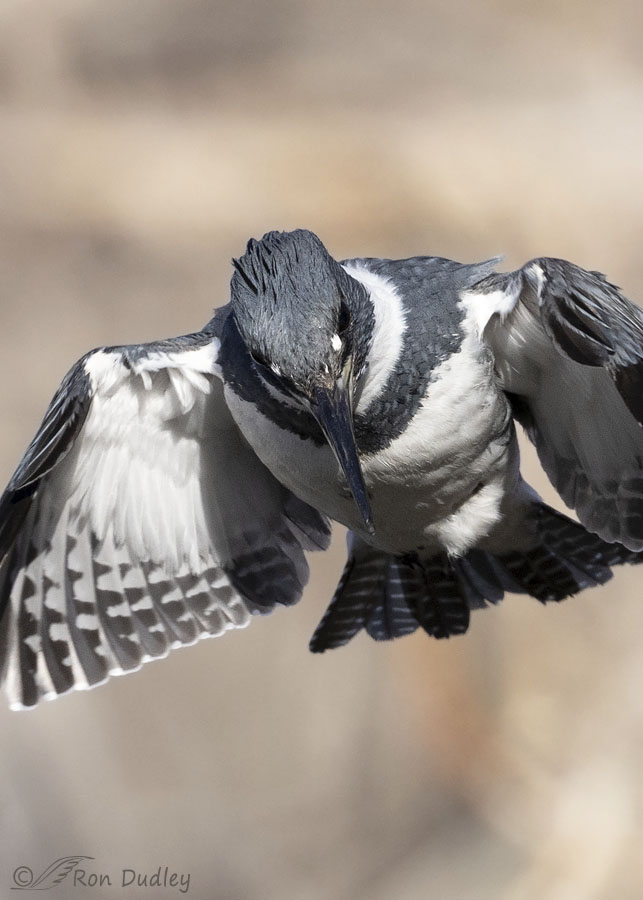
If you’re like me you’ve often wondered what the function of those highly conspicuous bright white spots in front of kingfisher eyes could possibly be. Here’s one theory:
“Some scientists call these white spots “false eyes,” and believe kingfishers use them as sighting devices to focus on prey. A kingfisher, theoretically, uses binocular vision to align the white spots while looking down its bill at a fish, like sights on a gun barrel. This allows the bird to accurately compensate for the refraction on the water’s surface that makes a fish or crayfish appear closer than it is.”


Late to the post today.
The change in photographic strategy paid off. Don’t think I’ve ever seen shots of a Kingfisher quite like these before.
All the photos are unique and quite beautiful. But, I really like #2. Closed/tucked-wing photos always seem to have a mystical weightlessness feel to them. And after all, art is best when felt rather than seen.
Wow! This a series that deserves to be framed and seen in sequence. It captivated me. Seriously, I had to look at this several times.
Also? That kingfisher needs a modeling contract. 🙂
“That kingfisher needs a modeling contract.”
He’s already got a big head to go with it, Arwen (with kingfishers it comes with the territory).
Great Shots! I love the white spot tidbit at the end of the blog.
Thank you, April.
Glad you ditched the muddy stick and came up with these fabulous hovering shots! I never knew that kingfishers were part hummingbird. 😉 He is quite the handsome member of his species too. I look at photographs like these and read your notes and the comments, then sit back and think, “Ain’t Nature grand!” 💜
“Ain’t Nature grand”
Marty, I can’t think of a phrase that my photos bring to mind for you that I like better than that one.
I’ll give all credit to you (and some to your R5) for the Kingfisher captures—which even without catchlights are fabulous—but may I suggest that magic 🪄 I mentioned yesterday may have had a hand in solving the sharpness issue? 😉
Chris, magic or not I’ll take it. No questions asked.
These are the best and clearest shots of a hovering kingfisher that I have seen. I’ve seen individual frames from a video and they are softer than these. Wonderful series.
Thanks very much, Dan. My change in tactics paid off.
I have no idea how you tracked him to the moment of hovering. However you did it the results are remarkable.
Very creative theory on the white spots. Engage refraction compensators, Scotty. Or Spotty.
“I have no idea how you tracked him to the moment of hovering”
I didn’t track him, Lyle – not with my lens. I just watched him with my naked eye and when he started hovering I managed to get him in frame and in focus before he stopped hovering and dove on the fish.
Well, who knew that fishing was so complicated?! Once again, you present amazing information – written and visual – which most of us would never even begin to think about. Thank you for the lesson!
Carolyn, this old teacher is delighted that you appreciated the lesson.
Congratulations on multiple fronts! These are excellent & interesting postures!!
Thank you, Kathleen.
Great series! An R5 and Ron Dudley victory on a very rapidly moving fellow!
You’re right, John. The R5 definitely contributed to my success.
I have never seen kingfishers hovering so clearly! When observing them along a stream or pond they move so quickly that I can’t get a good view. Thank you for this post. All of your pics are amazing. I hope you toasted your success with your favorite libation.
“I hope you toasted your success with your favorite libation”
Melanie, now that you mention it I certainly did!
Every photo is a wonder!! Thank you!!
Thanks, Mary.
I think I would sell my soul to be able to take shots of a KF like this. Just kidding, but these are remarkable Ron. I was thinking that their high speed smacking into the water must take a toll on their skull. As a biologist/nature scientist have you ever studied their physical properties relative to their diving?
These are all outstanding, but #3 is my favorite.
“have you ever studied their physical properties relative to their diving?”
No, I haven’t Everett. But I’ll bet they have some diving adaptations that we have no clue about.
Spectacular shots ! I’m fascinated with that theory about how those white spots
might function as “sighting devices”– I guess a person must have practiced at
least target shooting, if not actual hunting, to have come up with this insight ?
Really DYNAMIC shots — I’m glad that temperature glitch righted itself !
“I’m glad that temperature glitch righted itself”
Me too, Kris. We’ll see how long it lasts.
SPECTACULAR SERIES RON
Thanks, Charlotte.
Get the “creature of habit” 😉 It DOES have it’s advantages BUT! Glad you decided to break away from it for an experiment that worked well! 🙂 I didn’t miss the catch light at all. Interesting theory on the white dots…… 🙂
“It DOES have it’s advantages”
It certainly does, Judy. I hate to give some of them up to be more flexible but I guess we can’t have it both ways.
Great hovering shots! And the gremlins of technology keep us wondering. I blame string theory.
Thanks, Brett. Gravitons in particular… 🙂
Great shots, great post and a lesson for all of us. Where opportunity meets preparation, experience, thoughtful observation and knowledge.
“a lesson for all of us”
Perhaps, Granny Pat. But especially for me. I really am the poster child for “creature of habit”.